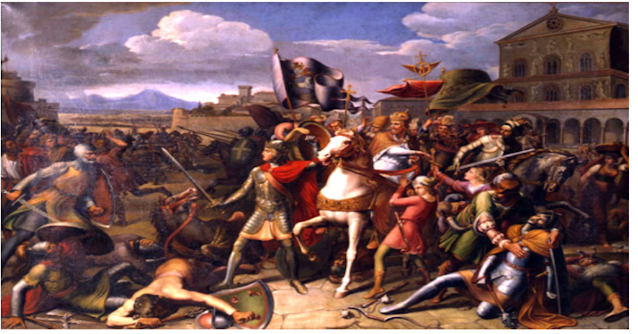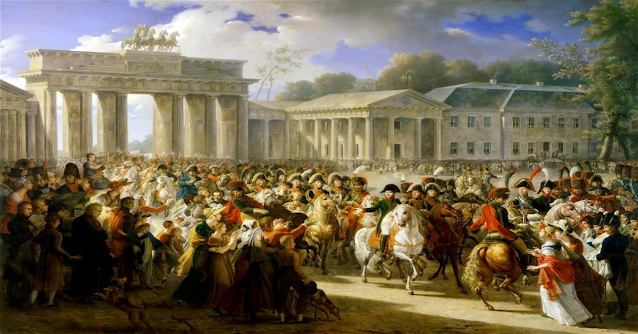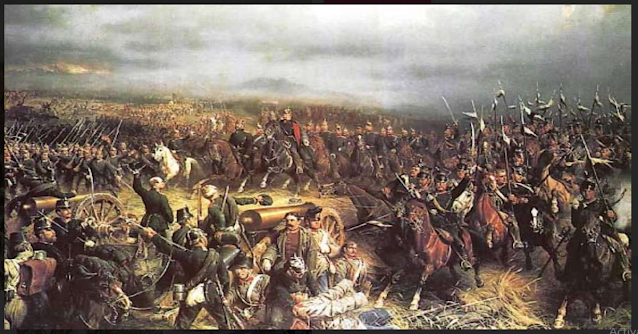Rise from Fragmentation: The Early Journey for Germanic Unity
The historical journey of the Germanic tribes is marked by a persistent lack of unity and fragmentation. Despite shared linguistic and cultural ties, the tribes struggled to overcome internal divisions and form a unified and lasting political entity. Austria, Switzerland, Liechtenstein, Luxembourg and Belgium either have German as an official language or have significant German-speaking populations, reflecting the presence and influence of the German ethnic group beyond the borders of Germany itself.
It was only in more recent history that Germany, as a unified nation-state, emerged. It's worth mentioning that Ostpolitik, a foreign policy strategy adopted by West Germany in the late 1960s and early 1970s under Chancellor Willy Brandt's leadership, played a significant role in the eventual reunification of Germany. This article aims to explore the historical and geopolitical background that led to a Unified-Germany in the 19th century.
💻Table of Contents:
- Early History and Fragmentation
- Napoleon and the Confederation of the Rhine
- Formation of the German Confederation: Seeking Stability
- The German Empire and Wilhelm II's Reign: A Turning Point in German History
- Conclusion: A summary of Transformative Journey
 |
| Frederick I Barbarossa |
Early History and Fragmentation:
Germany as a distinct region in Central Europe can be traced back to Julius Caesar, who called the unconquered area east of the Rhine "Germania." In the Battle of the Teutoburg Forest in AD 9, the Germanic tribes were successful in stopping the Romans from taking control of their land.
The Roman Empire, under the leadership of Emperor Augustus, sought to expand its territories and influence into the region known as Germania, which was inhabited by various Germanic tribes. However, the Germanic tribes, led by Arminius (also known as Hermann), achieved a significant victory by ambushing and defeating the Roman forces in the Teutoburg Forest. This defeat prevented the Roman Empire from fully annexing and incorporating the Germanic territories into its empire. This victory prevented the Romans from annexing the Germanic territories and allowed the Germanic tribes to maintain their independence.
After the Western Roman Empire collapsed, the Franks (A Germanic people who lived in present day France, Belgium, and parts of Germany), a powerful group of people, conquered other Germanic tribes in the region. The eastern part of the conquered lands became known as East Francia. In the year 962, Otto I became the first Holy Roman Emperor, ruling over a medieval German state.
The Holy Roman Empire, a Germanic Kingdom in Central Europe, existed from 962 to 1806. Frederick I Barbarossa, a prominent Holy Roman Emperor, added the word "holy" to the Empire's name to proclaim its authority alongside the claims of the Holy Church. He emphasized continuity with the past, particularly with the legacy of Charlemagne. Over time, the Holy Roman Empire expanded its territories through various means, including military victories, alliances, and dynastic marriages. It became a diverse Empire incorporating Germanic, Italian, and other European regions.
 |
| Greater German Empire |
Napoleon and the Confederation of the Rhine:
The Holy Roman Empire initially defended itself well against the French Revolutionary Wars, which erupted in 1792. However, war with France and the rise of Napoleon Bonaparte proved catastrophic for the Empire. Napoleon's military campaigns in Central Europe, particularly his victories in the Battle of Austerlitz and the Battleof Jena-Auerstedt, led to the decline of the Holy Roman Empire. Napoleon sought to weaken and overpower the German states, undermining the Empire's authority and control.
In 1806, the Holy Roman Empire faced significant pressure from Napoleon Bonaparte's forces. Francis II, who was the Holy Roman Emperor at the time, announced the dissolution of the empire due to this pressure. Napoleon's military campaigns and influence forced the German states within the Empire to secede and declare their independence. The term "secede" typically refers to the act of formally withdrawing or separating from a larger political entity. In this context, the German states were effectively separating themselves from the control and authority of the Holy Roman Empire due to the forcible actions and influence of Napoleon.
As a result, the imperial crown, which symbolized the authority of the Holy Roman Emperor, was relinquished. This marked the end of the Holy Roman Empire as a political entity. This fragmentation was a defining feature of the German political landscape and hindered the emergence of a unified nation.
 |
| Fall of Berlin 1806 |
The Napoleonic era played a pivotal role in reshaping Europe, including the German territories. Napoleon's conquests and restructuring of the political map led to the creation of the Confederation of the Rhine in 1806. The Confederation of the Rhine was a political and military alliance under the influence of Napoleon Bonaparte. It was composed of various German states and territories, including some that were formerly part of the Holy Roman Empire.
The Confederation of the Rhine aimed to replace the fragmented political structure of the Holy Roman Empire with a more centralized and Napoleonic-aligned entity. It was led by Napoleon as its Protector and included powerful states like Bavaria, Württemberg, and Saxony. The Confederation dissolved in 1813 following Napoleon's defeat in the War of the Sixth Coalition, marking the end of its short-lived existence.
Formation of the German Confederation: Seeking Stability
The Congress of Vienna, held from 1814–1815, was a set of international diplomatic meetings to discuss and agree on how to organize Europe after Napoleon Bonaparte lost power. Delegates from all European countries attended these meetings, which were led by an Austrian statesman named Klemens von Metternich. The gatherings took place in Vienna from September 1814 to June 1815.
Prussia, as one of the major European powers at the time, was represented at the Congress. The Prussian delegation, led by Prince Karl August von Hardenberg, played a significant role in the negotiations and discussions that took place during the conference. Prussia sought to secure territorial gains and increase its influence in Central Europe.
 |
| Austro-Prussian War |
The German Confederation was formed in 1815 during the Congress of Vienna. The primary goal of the Confederation was to bring stability to the German-speaking territories of Central Europe, which had been politically fragmented for centuries.
The German Confederation was a loose association of 39 independent German states, including larger entities like Austria and Prussia, as well as smaller principalities and free cities. The Confederation was established to replace the disbanded Holy Roman Empire, dissolved by Napoleon in 1806.
Key principles of the German Confederation included maintaining the sovereignty and independence of its member states, collective defense against external aggression, and a commitment to a federal structure where each state retained its own government and autonomy.
While the Confederation represented an attempt to address the political vacuum left by Napoleon's defeat, it faced challenges. The differing interests of major states, particularly Austria and Prussia, and the absence of a centralized authority, limited its effectiveness.
The German Empire and Wilhelm II's Reign: A Turning Point in German History
The German Empire was established in 1871 under the leadership of Chancellor Otto von Bismarck. It marked the culmination of a series of events that led to the unification of the German-speaking states into a single nation-state. Bismarck, through a combination of diplomacy and military victories, orchestrated the unification process. He skillfully played off rival powers and exploited regional conflicts to his advantage. The Franco-Prussian War of 1870-1871, in which Prussia emerged victorious, was a key catalyst for German unification.
Following the war, the German Empire was proclaimed in the Palace of Versailles, with King Wilhelm I of Prussia being proclaimed as Emperor Wilhelm I of Germany. The Empire encompassed a significant portion of Central Europe and included powerful states such as Prussia, Bavaria, Saxony, and others. Under Bismarck's leadership, the German Empire experienced a period of rapid industrialization and economic growth. Bismarck implemented a series of social reforms, including the establishment of a social welfare system, to appease the working class and maintain stability.
However, tensions within the empire persisted. Disputes between the central government and regional powers, as well as cultural and political differences among the member states, created ongoing challenges. Bismarck's authoritarian rule and suppression of dissent also contributed to boiling tensions. Bismarck's resignation in 1890 marked a turning point in German history. The subsequent reign of Emperor Wilhelm II also adopted a more self-driven approach in his policies and actions on the global stage. Germany pursued an aggressive foreign policy, which contributed to the outbreak of World War I in 1914.
Conclusion: A summary of Transformative Journey
The defeat of Germany in World War I led to the collapse of the empire and the establishment of the Weimar Republic. This period was marked by political instability, economic hardship, and social unrest. The rise of Adolf Hitler and the Nazi Party in the 1930s led to the establishment of the Third Reich.
Under Hitler's totalitarian regime, Germany embarked on a path of aggressive expansionism and perpetrated horrific crimes during World War II, culminating in the Holocaust and the devastation of much of Europe. Following Germany's defeat in World War II, the country was divided into East Germany (German Democratic Republic) and West Germany (Federal Republic of Germany). The division was a result of the Cold War tensions between the Soviet Union and Western powers.
The fall of the Berlin Wall in 1989 and the subsequent reunification of East and West Germany in 1990 marked a significant milestone in German history. The unified Germany, known as the Federal Republic of Germany, emerged as a prosperous and influential nation in the heart of Europe. Today, Germany is a leading global economic power and a key player in European politics. It has established itself as a democratic nation with a strong emphasis on human rights, social welfare, and international cooperation.





